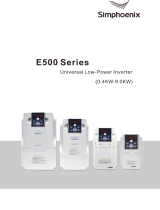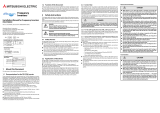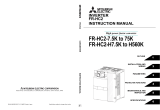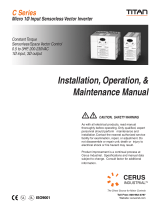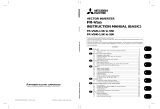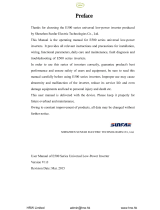Page is loading ...

TRANSISTORIZED INVERTER
FR-CV
INSTRUCTION MANUAL
IB(NA)-0600075-C(0807)MEE Printed in Japan Specifications subject to change without notice.
OUTLINE
1
INSTALLATION
AND WIRING
2
3
SPECIFICATIONS
4
HEAD OFFICE:TOKYO BUILDING 2-7-3, MARUNOUCHI, CHIYODA-KU, TOKYO 100-8310, JAPAN
FR-CV
INSTRUCTION MANUAL
TRANSISTORIZED INVERTER
PROTECTIVE
FUNCTIONS
C
FR-CV-7.5K to 30K(-AT)
FR-CV-37K, 55K
FR-CV-H7.5K to H30K(-AT)
FR-CV-H37K, H55K
FR-CVL-7.5K to 55K
FR-CVL-H7.5K to H55K
POWER REGENERATION
COMMON CONVERTER

A-1
Thank you for choosing this Mitsubishi transistorized inverter option unit. This instruction manual provides
handling information and precations for use of the equipment. Before using the inverter option, always read
this instruction manual carefully to use the equipment to its optimum.
Please forward this instruction manual to the end user.
This instruction manual uses the International System of Units (SI). The measuring units in the yard and
pound system are indicated in parentheses as reference values.
1. Electric Shock Prevention
2. Fire Prevention
3.Injury Prevention
This section is specifically about safety matters
Do not attempt to install, operate, maintain or inspect the inverter until you have read through the instruction
manual and appended documents carefully and can use the equipment correctly.In this instruction manual, the
safety instruction levels are classified into "WARNING" and "CAUTION"
.
Assumes that incorrect handling may cause hazardous conditions, resulting in
death or severe injury.
Assumes that incorrect handling may cause hazardous conditions, resulting in
medium or slight injury, or may cause physical damage only.
Note that even the level may lead to a serious consequence according to conditions. Please
follow the instructions of both levels because they are important to personnel safety.
z While power is on or when the inverter is running, do not open the terminal block cover. You may get an
electric shock.
z Do not run the inverter with the terminal block cover removed. Otherwise, you may access the exposed
high-voltage terminals or the charging part of the circuitry and get an electric shock.
z Before starting wiring or inspection, switch off power, check to make sure that the charge lamp is off, wait
for at least 10 minutes after the power supply has been switched off, and check that there are no residual
voltage using a tester or the like. The capacitor is charged with high voltage for some time after power off
and it is dangerous.
z Earth (ground) the inverter.
z Any person who is involved in wiring or inspection of this equipment should be fully competent to do the
work.
z Always install the inverter before wiring. Otherwise, you may get an electric shock or be injured.
z Perform setting dial and key operations with dry hands to prevent an electric shock.
z Do not subject the cables to scratches, excessive stress, heavy loads or pinching. Otherwise, you may get
an electric shock.
z Mount the power regeneration common converter unit and dedicated stand-alone reactor unit to
incombustible material. Mounting it to or near combustible material can cause a fire.
z Do not connect a resistor directly to the DC terminals P/L+, N/L-. This could cause a fire.
z Apply only the voltage specified in the instruction manual to each terminal to prevent damage etc.
z Ensure that the cables are connected to the correct terminals. Otherwise damage etc. may occur.
z Always make sure that polarity is correct to prevent damage etc.
z While power is on and for some time after power-off, do not touch the power regeneration common
converter unit and dedicated stand-alone reactor unit as they are hot and you may get burnt.
zWhen changing the fan, take care not to get injured.
WARNING
CAUTION
CAUTION
WARNING
CAUTION
CAUTION

A-2
4. Additional Instructions
Also note the following points to prevent an accidental failure, injury, electric shock, etc.
1) Transportation and installation
2) Operation
3) Maintenance, inspection and parts replacement
4) Emergency stop
5) Disposing of the inverter
6) General instructions
zWhen carrying products, use correct lifting gear to prevent injury.
zDo not stack the inverter option boxes higher than the number recommended.
zEnsure that installation position and material can withstand the weight of the inverter.
z Do not operate if the power regeneration common converter is damaged or has parts missing.
z When carrying the inverter option, do not hold it by the terminal block cover or setting dial; it may fall off or
fail.
z Do not stand or rest heavy objects on the inverter option.
z Check the inverter option mounting orientation is correct.
z Prevent screws, wire fragments, other conductive bodies, oil or other flammable substances from entering
the power regeneration common converter.
z Do not drop the power regeneration common converter, or subject it to impact.
z Use the inverter option under the following environmental conditions. Using it outside the operating range
can cause the power regeneration common converter to become faulty.
*Temperature applicable for a short time, e.g. in transit.
z Do not modify the equipment.
zDo not perform parts removal which is not instructed in this manual. Doing so may lead to fault or damage
of the product.
z Do not carry out a megger (insulation resistance) test on the control circuit of the power regeneration
common converter unit.
z When the breaker on the power regeneration common converter input side trips, check for the wiring fault
(short circuit), damage to internal parts of the power regeneration common converter, etc. Identify the
cause of the trip, then remove the cause and power on the breaker.
z Treat as industrial waste
Many of the diagrams and drawings in this instruction manual show the inverter without a cover, or partially
open. Never operate the inverter in this like. Always replace the cover and follow this instruction manual
when operating the inverter.
CAUTION
Environment
Ambient
temperature
-10°C to +50°C (14°F to 122°F) (non-freezing)
Ambient
humidity
90%RH or less (non-condensing)
Storage
temperature
-20°C to +65°C* (-4°F to 149°F)
Ambience Indoors (free from corrosive gas, flammable gas, oil mist, dust and dirt)
Altitude, vibration
Maximum 1000m (3280.80feet) above sea level for standard operation.
After that derate by 3% for every extra 500m (1640.40feet) up to
2500m (8202.00feet) (91%). 5.9m/s
2
or less
WARNING
CAUTION
CAUTION
CAUTION

i
CONTENTS
CONTENTS
1 OUTLINE 1
1.1 Pre-Operation Information ..................................................................................... 2
1.1.1 Precautions for operation .......................................................................................................... 2
1.2 Basic Configuration................................................................................................ 4
1.2.1 Basic configuration .................................................................................................................... 4
1.3 Structure ................................................................................................................ 5
1.3.1 Appearance and structure ......................................................................................................... 5
1.3.2 Removal and reinstallation ........................................................................................................ 6
1.3.3 Structure of the power regeneration common converter ........................................................... 8
2 INSTALLATION AND WIRING 9
2.1 Installation............................................................................................................ 10
2.1.1 Instructions for installation ....................................................................................................... 10
2.2 Wiring................................................................................................................... 12
2.2.1 Terminal connection diagram .................................................................................................. 12
2.2.2 Wiring of the main circuit ......................................................................................................... 14
2.2.3 Wiring of the control circuit ...................................................................................................... 21
2.2.4 Design information................................................................................................................... 22
2.3 Operation ............................................................................................................. 23
2.3.1 Pre-operation checks............................................................................................................... 23
2.3.2 Power-on and operation .......................................................................................................... 23
2.4 Other wiring.......................................................................................................... 24
2.4.1 Power harmonics..................................................................................................................... 24
2.4.2 Noise types and reduction techniques..................................................................................... 25
2.4.3 Peripheral devices ................................................................................................................... 26
2.4.4 Instructions for UL and cUL ..................................................................................................... 28
3 PROTECTIVE FUNCTIONS 29
3.1 Errors (Alarms)..................................................................................................... 30
3.1.1 Error (alarm) definitions ........................................................................................................... 30
3.1.2 Alarm symptoms and check points.......................................................................................... 31
3.2 Precautions for Maintenance and Inspection....................................................... 32
3.2.1 Precautions for maintenance and inspection........................................................................... 32
3.2.2 Check items............................................................................................................................. 32
3.2.3 Periodic inspection .................................................................................................................. 32
3.2.4 Insulation resistance test using megger .................................................................................. 33
3.2.5 Pressure test ........................................................................................................................... 33
3.2.6 Daily and Periodic Inspection .................................................................................................. 34
3.2.7 Replacement of parts .............................................................................................................. 36
3.2.8 Measurement of main circuit voltages, currents and power .................................................... 40

ii
4 SPECIFICATIONS 43
4.1 Standard Specifications ....................................................................................... 44
4.1.1 Model specifications ................................................................................................................ 44
4.1.2 Internal block diagram ............................................................................................................. 47
4.1.3 Outline drawings...................................................................................................................... 48

1
4
3
2
1
CHAPTER 1
OUTLINE
1.1 Pre-Operation Information ......................... 2
1.2 Basic Configuration.................................... 4
1.3 Structure ...................................................... 5
This chapter gives information on the basic "outline" of this
product.
Always read the instructions in this chapter before using the
equipment.

2
Pre-Operation Information
1.1 Pre-Operation Information
1.1.1 Precautions for operation
Incorrect handling might cause the inverter option to operate improperly, its life to be reduced considerably, or at the
worst, the inverter option to be damaged. Handle the power regeneration common converter properly in accordance
with the information in each section as well as the precautions and instructions of this manual to use it correctly.
This manual is written for the power regeneration common converter FR-CV.
For handling information on the inverter, stand-alone options, etc., refer to the corresponding manuals.
(1) Unpacking and product check
Unpack the power regeneration common converter and check the capacity plate on the front cover and the rating
plate on the inverter side face to ensure that the product agrees with your order and the inverter is intact.
1) Definition of the power regeneration common converter type
2) The power regeneration common converter accessory
Instruction manual
3) Definition of the dedicated stand-alone reactor
Remember to prepare the dedicated stand-alone reactor as it must be installed.
If you have found any discrepancy, damage, etc., please contact your sales representative.
(2) Confirmation of the peripheral device types
The dedicated stand-alone reactor must be installed.
Power regeneration common converter Dedicated stand-alone reactor (required)
FR-CV-7.5K(-AT) FR-CVL-7.5K
FR-CV-11K(-AT) FR-CVL-11K
FR-CV-15K(-AT) FR-CVL-15K
FR-CV-22K(-AT) FR-CVL-22K
FR-CV-30K(-AT) FR-CVL-30K
FR-CV-37K FR-CVL-37K
FR-CV-55K FR-CVL-55K
Note: 400Vclass devices have capacity numbers preceded by H in their type codes.
FR-CV-11K
Converter type Serial number
Capacity plate
Rating plate
MITSUBISHI
MODEL
INVERTER
FR-CV-11K
INPUT :
OUTPUT :
SERIAL :
XXXXX
XXXXX
PASSED
Serial number
Converter
type
Capactiy plate
Rating plate
FR-CV- K-
Symbol
7.5 to 55
Applicable Inverter
Capacity
Indicates capacity
in "kW".
Symbol
None
AT
Structure
Heat sink outside mounting structure
Enclosure inside installation structure
Symbol
None
H
Voltage class
200V class
400V class
Input rating
Output rating
FR-CVL-11K
Capacity plate
FR-CVL- K
Symbol
7.5 to 55
Applicable Converter
Capacity
Indicates capacity
in "kW".
Symbol
None
H
Voltage class
200V class
400V class
Capacity plate
Reactor type

3
Pre-Operation Information
OUTLINE
1
(3) Installation
To operate the power regeneration common converter with high performance for a long time, install the inverter in a
proper place, in the correct direction, and with proper clearances. (Refer to page 10.)
(4) Wiring
Connect the power supply, inverter and control signals to the terminal block. Note that incorrect connection may
damage the power regeneration common converter , inverter and peripheral devices. (Refer to page 10.)

4
Basic Configuration
1.2 Basic Configuration
1.2.1 Basic configuration
The following devices are required to operate the power regeneration common converter. Proper peripheral devices
must be selected and correct connections made to ensure proper operation. Incorrect system configuration and
connections can cause the inverter to operate improperly, its life to be reduced considerably, and in the worst case,
the inverter to be damaged.
Please handle the product properly in accordance with the information in each section as well as the precautions
and instructions of this manual. (For connections of the peripheral devices, refer to the corresponding manuals.)
Note: If connected to the inverter, the power factor improving DC reactor (FR-BEL) does not produce an effect on
power factor improvement. In addition, do not use the power factor improving AC reactor (FR-BAL) since
using it may degrade the power regeneration function.
(MC)
(ELB)
or
(NFB)
Earth(Ground)
Earth
(Ground)
Earth
(Ground)
Power regeneration
common converter
(FR-CV)
Dedicated Stand-alone
reactor (FR-CVL)
Earth(Ground)
Name Description
Power supply
Use the power supply within the permissible power
supply specifications of the power regeneration
common converter.
(Refer to page 44.)
Earth leakage
circuit breaker
(ELB) or no-fuse
breaker(NFB)
The breaker should be selected with care since a
large inrush current flows in the power regeneration
common converter at power on. (Refer to page 26.)
Magnetic
contactor
Install the magnetic contactor to ensure safety.
When installed, do not use it to start or stop the
inverter. It might reduce the power regeneration
common converter life.
(Refer to page 26.)
Installation of
dedicated
stand-alone
reactor
For power coordination, always install the
dedicated stand-alone reactor.
Power
regeneration
common
converter
Incorrect wiring might lead to power regeneration
common converter damage. The control signal lines
should be kept away from the main circuit to protect
them from noise.
Inverter
•Use the compatible inverter.
•The inverter life is influenced by ambient
temperature.The ambient temperature should be
as low as possible within the permissible range.
This must be noted especially when the inverter is
installed in an enclosure .
•Incorrect wiring might lead to inverter damage.The
control signal lines should be kept away from the
main circuit to protect them from noise.
Devices
connected to the
output
Do not connect a power capacitor, surge suppressor
or radio noise filter to the output side.
Earth(Ground)
To prevent an electric shock, always ground the
dedicated stand-alone reactor, power regeneration
common converter, motor and inverter.
The grounding cable provided for reduction of
induction noise from the power line of the inverter is
recommended to be wired by returning it to the
grounding terminal of the inverter.
Note: Note that when an electromagnetic
contactor (MC) and a no-fuse breaker
(NFB) are installed, switching off the
inverter during operation, then on again
will cause a starting current to flow,
affecting the inverter and motor. When
installing a no-fuse breaker (NFB) on the
output side, contact the NFB manufacturer
for selection of no-fuse breaker.

5
Structure
OUTLINE
1
1.3 Structure
1.3.1 Appearance and structure
FR-CV-7.5K to 30K (-AT), FR-CV-H7.5K to H30K (-AT)
(1) Front view (2) Without front cover
FR-CV-37K/55K, FR-CV-H37K/H55K
(1) Front view (2) Without front cover
Note: Keep the connector for manufacturer setting open.
Capacity plate
CHARGE lamp
Main cricuit terminal block cover
Rating plate
Cooling fan
Connector cover for manufacturer
setting
Earth screws
LED display
Control circuit terminal block cove
r
Control circuit terminal block
Main circuit terminal block
Connector for manufacturer
setting (Note)
Capacity plate
Control circuit terminal block cove
r
CHARGE lamp
Main circuit terminal block cover
Rating plate
Front cover
Fix ture
Maker setting connector cover
LED display
Control circuit terminal block
Main circuit terminal block
Maker setting connector (Note
)

6
Structure
1.3.2 Removal and reinstallation
(1) Main circuit terminal block cover
FR-CV-7.5K to 30K (-AT), FR-CV-H7.5K to H30K(-AT)
zRemoval
1)Hold both ends of the cover bottom and pull it toward you.
2)When the bottom of the cover has come off, hold both ends of the cover top and pull it toward you.
zReinstallation
1)Insert the catch at the cover top into the socket in the unit.
2)Using the part of the catch as a support, securely press the catches at both ends of the cover bottom to
the unit.
FR-CV-37K/55K, FR-CV-H37K/H55K
zRemoval
1)Remove the installation screws at the top of the main circuit terminal block cover.
zReinstallation
1)Fix the main circuit terminal block cover with the installation screws.

7
Structure
OUTLINE
1
(2) Control circuit terminal block cover
zOpening
1)Hold the right end of the cover and pull it toward you.
2)The cover opens, with the left-hand side of the cover acting as a support.
zClosing
1)Securely press the right end of the cover against the unit.
Note: Make sure that the cover has been fitted securely.

8
Structure
1.3.3 Structure of the power regeneration common converter
The power regeneration common converter is available in two types: a heat sink outside mounting structure model
and an enclosure inside installation structure model.
(1) Heat sink outside mounting structure model (FR-CV-7.5K to 55K, FR-CV-H7.5 to H55K)
The FR-CV-37K, 55K and FR-CV-H37K, H55K can be used either as a heat sink outside mounting structure model
or an enclosure inside installation structure model by changing its mounting foot position. It is shipped from the
factory as a heat sink outside mounting structure model. Change the mounting foot position as shown below for
installation.
(2) Enclosure inside installation structure model
(FR-CV-7.5K to 30K-AT, FR-CV-H7.5K to H30K-AT)
Power regeneration
common converter
Cooling
fan
Heat
sink
Enclosure
Inside
Outside
Heat sink outside mounting
(At factory shipment)
Enclosure inside installation
Factory-set mounting
foot position
Power regeneration
common converter
Heat
sink
Cooling fan
Enclosure
Inside
Outside

9
4
3
2
1
CHAPTER 2
INSTALLATION AND WIRING
2.1 Installation ................................................... 10
2.2 Wiring........................................................... 12
2.3 Operation ..................................................... 23
2.4 Other wiring................................................. 24
This chapter gives information on the basic "Installation and
wiring" of this product.
Always read the instructions in this chapter before using the
equipment.

10
Installation
2.1 Installation
2.1.1 Instructions for installation
1) Handle the unit carefully.
The power regeneration common converter uses plastic parts. Handle it gently to protect it from damage. Also,
hold the unit with even strength and do not apply too much strength to the terminal block cover alone.
2) Install the inverter in a place where it is immune to vibration. (5.9 m/s
2
or less)
Also note the cart, press, etc.
3) Note on ambient temperature
The power regeneration common converter life is under great influence of ambient temperature. Exercise care
so that the ambient temperatures of the installation place do not fall out of the permissible range (-10°C to
+50°C (14°F to 120°F)). Make sure that the ambient temperatures are within the permissible range at the
measurement positions given in 3) on the next page. It is important to check that not only the ambient
temperatures of the power regeneration common converter but also those of the inverter contained in the same
enclosure fall within the permissible range.
4) Notes on installation surface
The power regeneration common converter will be very hot (maximum about 150°C (302°F)).
The power regeneration common converter (heat sink outside mounting structure model) can be reduced in the
enclosure inside temperature by mounting its heat sink outside the enclosure. Cut the mounting area according
to the panel cutting dimensions. Since the cooling section located outside the enclosure has a cooling fan, do
not use the equipment in the environment that has water drops, oil mists, dust particles, etc. For installation in
an enclosure, use the enclosure inside installation structure model of the power regeneration common
converter and install it on an incombustible (e.g. metal) mounting surface.
Also leave sufficient clearances around the inverter.
5) Avoid high temperature and high humidity.
Avoid direct sunlight and places of high temperature and high humidity.
6) Avoid places where the inverter option is exposed to oil mist, flammable gases, fluff, dust, dirt etc.
Install the inverter option in a clean place or inside a "totally enclosed" panel which does not accept any
suspended matter.
7) Note the cooling method when the power regeneration common converter and inverter is installed in an
enclosure.
When two or more power regeneration common converters and inverters are installed or a ventilation fan is
mounted in an enclosure, the inverters and ventilation fan must be installed in proper positions with extreme
care taken to keep the ambient temperatures of the power regeneration common converters and inverters
below the permissible value. If they are installed in improper positions, the ambient temperatures of the power
regeneration common converters and inverters will rise and ventilation effect will be reduced.
8) Install the power regeneration common converter and inverter securely in the vertical direction with screws or
bolts.
9) Install the dedicated stand-alone reactor (FR-CVL) on horizontal plane. Failure to observe this may lead to
damage of the reactor.

11
Installation
INSTALLATION AND WIRING
2
3) Note on ambient temperature 4) Clearances around the inverter
7) For installation in an enclosure
8) Vertical mounting
Power regeneration common converter
9) Horizontal plane installation
Dedicated stand-alone reactor
5cm
(1.97 inches)
5cm
(1.97 inches)
FR-CV
Measurement
p
osition
Measurement
position
5cm
(1.97 inches)
FR-CV
5cm (1.97 inches)
or moer
10cm
(3.94 inches)
or more
10cm
(3.94 inches)
or more
5cm (1.97 inches)
or moer
Clearances required to
change the cooling fan of
the enclosure inside
installation structure model
(-AT). (Refer to page 36 for
fan replacement.)
Converter
Ventilation
fan
(Incorrect example)
Position of Ventilation Fan
(Correct example)
Converter
Converter
Built-in cooling fan
Converter
Converter
Converter
Accommodation of two or more inverters
(Correct example)
(Incorrect example)

12
Wiring
2.2 Wiring
2.2.1 Terminal connection diagram
Be sure to connect terminal RDY of the FR-CV to the X10 or MRS signal assigned terminal of the
inverter, and connect terminal SE of the FR-CV to terminal SD of the inverter. Without proper
connecting, FR-CV will be damaged.
MCNFB
R/L11
FR-CVL
S/L21
T/L31
R2/L12
S2/L22
T2/L32
R2/L1
S2/L2
T2/L3
R/L11
S/L21
T/MC1
P/L+
N/L-
RES
SD
SD
P24
SE
RDYB
RS0
A
B
C
R/L1
S/L2
T/L3
R1/L11
S1/L21
P/+
N/-
PC
SD
X10 (MRS)
RES
SD
FR-A720
U
V
W
IM
(Note 1)
R/L1
S/L2
T/L3
R1/L11
S1/L21
P/+
N/-
X10 (MRS)
RES
SD
FR-A720
U
V
W
IM
R/L1
S/L2
T/L3
R1/L11
S1/L21
P/+
N/-
X10 (MRS)
RES
SD
FR-A720
U
V
W
IM
(Note 3)
FR-CV
RDYA
3-phase
AC power supply
Open collector
outputs
(Note 1)
(Note 3)
(Note 1)
(Note 3)
Main circuit terminal
Control circuit input terminal
Control circuit output terminal
R
S
T
(Note 4)
(Note 4)
(Note 5)
(Note 2)
(Note 7)
(Note 2)
(Note 7)
(Note 2)
(Note 7)
Note : 1. Never connect a power supply to the inverter terminals R, S, T.
Such a connection, even if accidental, will damage the inverter
and power regeneration common converter.
2. Match the polarities of the P and N terminals by connecting
terminal P of the inverter to terminal P of the power
regeneration common converter and terminal N of the inverter
to terminal N of the power regeneration common converter as
shown in the connection example. Incorrect matching of
the polarities of the P and N terminals will result in damage
to the inverter.
Do not remove a jumper across terminal P/+ and P1.
3. For the FR-A700, F700, A500, F500 and V500 series, remove
the jumpers across terminals R-R1 and S-S1, and connect
power supply to terminals R1, S1 for the control circuit. For the
FR-E700, D700, E500, S500, C500 and F500J series, the
inverter does not have terminals R1, S1. So you do not need to
make this connection.
4. When wiring the dedicated stand-alone reactor and power
regeneration common converter as well as when wiring
the power supply and terminals R/L11, S/L21, T/MC1, strictly
observe the wiring order as shown in the connection example
(match phase sequence of the power supply).
A wrong connection will damage the power regeneration
common converter.
Do not insert an MCCB nor MC. The power regeneration
common converter functions abnormally.
5. Make sure terminals R/L11, S/L21, T/MC1 are connected to
the power supply. Running the inverter without connecting
these terminals will damage the power regeneration common
converter.
6. Since power to the inverter is supplied by terminals P and N,
set Pr.30 to 2 (for use with a high power factor converter, power
regeneration common converter) for the FR-A700, F700, A500,
F500 and V500 series. This setting disables the built-in brake
resistor.
7. For the FR-A700, F700, E700, D700, A500, F500 and V500
series inverter, assign the X10 signal to any of input terminals to
use the inverter.
8. You can connect up to six inverters to one power regeneration
common converter.
9. Use sink logic (factory setting) when the FR-CV is connected.
The FR-CV cannot be connected when source logic is selected.
CAUTION

13
Wiring
INSTALLATION AND WIRING
2
(1) Description of main circuit terminals
(2) Description of control circuit terminals
(3) Description of inverter connection terminals
Symbol Terminal Name Description
R2/L1, S2/
L2,T2/L3
AC power input Connect to the dedicated stand-alone reactor terminals R2/L12, S2/L22, T2/L32.
P/L+, N/L- DC power output
Connect to the inverter terminals P, N, and keep the inverter terminals R, S, T open.
For the FR-A700, F700, A500, F500 or V500 series, set 2 (for use of high power
factor converter, power regeneration common converter) in Pr.30.
R/L11, S/
L21, T/MC1
Power supply phase
detection
Terminals for power supply phase, power voltage detection and control power input.
Connect to the dedicated stand-alone reactor terminals R/L11, S/L21, T/L31.
Running the inverter without connecting these terminals will damage the power
regeneration common converter.
Ground Securely connect to the earth.
Type Symbol Terminal Name Description
Input signals
Power input, contact
P24 24VDC input
Used to input 24VDC power for alarm output relay drive and reset drive signal
drive. Connect to the inverter terminal PC. When you do not use the inverter
terminal PC, prepare a 24VDC power supply.
Permissible input voltage fluctuation: 22V to 26VDC
RES Reset
Used to reset the activated protective circuit. Turn the terminals RES-SD on for
longer than 0.1 seconds, then turn them off.
SD
24VDC power common
Contact input common
Connect the common of the 24VDC power supply.
Shorting the terminal RES and this terminal inputs the reset signal.
Output signals
Open collector
RDYA Ready output
Outputs a signal when the power regeneration common converter is ready to
operate.
This output has opposite logic to RDYB.
Permissible load 24V 0.1ADC
RDYB
Inverter
operation enable
Outputs a signal when the power regeneration common converter is faulty or the
reset signal is input. Connect to the X10 (MRS) signal of the inverter. This output
has opposite logic to RDYA.
Permissible load 24V 0.1ADC
RSO Converter reset
Outputs the reset signal to the inverter when the reset signal is input to the power
regeneration common converter. Connect to the inverter terminal RES.
Permissible load 24V 0.1ADC
SE
Open collector output
common
Common to the terminals RDYA, RDYB and RSO. Connect to the inverter
terminal SD.
Contact
A, B, C Alarm output
Change-over outputs which indicate that the protective function of the power
regeneration common converter was activated to stop the output.
Alarm: No continuity across B-C (continuity across A-C), normal: Continuity across
B-C (no continuity across A-C)
Permissible load 230V 0.3AAC, 30V 0.3ADC
Type Symbol Terminal Name Description
Main circuit
P, N DC power input Connect to the power regeneration common converter terminals P/L+, N/L-.
R1, S1
Control circuit power
input
For the FR-A700, F700, A500, F500 or V500 series, remove the jumpers across
the inverter terminals R-R1 and S-S1, and input external power to these terminals.
For the FR-E500, S500, C500 or F500J series, the inverter does not have the
terminals R1, S1 so uses the DC power input from the terminals P, N as the control
power.
Ground Securely connect to the earth.
Control circuit
X10
(MRS)
Output stop
Shuts off the inverter output when the power regeneration common converter is
faulty or the converter reset signal is input. Connect to the power regeneration
common converter terminal RDYB. For the FR-A700, F700, E700, D700, A500,
F500 or V500 series, assign the X10 signal to any of the input terminals. For the
FR-E500, S500, C500 or F500J series, use the terminal MRS as you cannot
assign the X10 signal. If the terminal MRS is already used, assign another MRS
signal to any of the input terminals.
RES Converter reset
When the reset signal is input to the power regeneration common converter, the
reset signal is also input to the inverter. Connect to the power regeneration
common converter terminal RSO. For the D700, S500, C500 and F500J series,
assign the RES signal to any one of the input terminals.
PC 24VDC power
24V 0.1ADC power. Connect to the power regeneration common converter
terminal P24.(Note)
SD Contact input common
Common to the contact input terminals. Also acts as a common to the 24V
0.1ADC power (terminal PC).
Note: When used as the 24V power, the terminal PC cannot prevent a sneak path for transistor output.

14
Wiring
2.2.2 Wiring of the main circuit
(1) Wiring instructions
1) Crimping terminals with insulation sleeves are recommended for use with the power and inverter cables.
2) Strictly observe the order of wiring in the connection example when performing wiring between the dedicated
stand-alone reactor and power regeneration common converter and wiring between the power supply and
terminals R/L11, S/L21, T/MC1. (Match the phase sequence of the power supply.) Incorrect connection will
damage the power regeneration common converter.
3) Make sure to connect the terminal R/L11, S/L21, T/MC1 to the power supply.
Running the inverter without connecting the terminals will damage the power regeneration common converter.
4) Connect a DC power supply between the power regeneration common converter and inverter with correct
polarity.
5) After wiring, wire off-cuts must not be left in the power regeneration common converter.
Wire off-cuts can cause an alarm, failure or malfunction. Always keep the power regeneration common
converter clean.
When drilling mounting holes in a control box etc., exercise care to prevent chips and other foreign matter from
entering the power regeneration common converter.
6) Electromagnetic wave interference
The input/output (main circuit) of the power regeneration common converter and inverter includes harmonic
components, which may interfere with the communication devices (such as AM radios) used near the power
regeneration common converter and inverter. In this case, install the FR-BIF optional radio noise filter (for use
in the input side only) or FR-BSF01 or FR-BLF line noise filter to minimize interference.
7) When rewiring after operation, make sure that the CHARGE lamp has gone off, and when more than 10
minutes have elapsed after power-off, check with a meter that the voltage is zero. After that, start rewiring work.
For some time after power-off, there is a dangerous voltage in the capacitor.
8) Be sure to connect terminal RDY of the FR-CV to the X10 or MRS signal assigned terminal of the inverter, and
connect terminal SE of the FR-CV to terminal SD of the inverter. Without proper connecting, FR-CV will be
damaged.
Notes on Grounding
z To prevent an electric shock, the dedicated stand-alone reactor, power regeneration common converter, inverter and
motor must be grounded.
z Use the dedicated ground terminal to ground the power regeneration common converter. (Do not use the screws in
the case, chassis, etc.)
z Use the reactor mounting screw to earth the dedicated stand-alone reactor.
Use the screw in the marked .
z The ground cable should be as thick as possible. Its gauge should be equal to or larger than those indicated in the
following table. The grounding point should be as near as possible to the power regeneration common converter to
minimize the ground cable length.
(Unit: mm
2
)
Capacity
Ground Cable Gauge
200V class 400V class
7.5kW (10HP) 5.5 3.5
11kW, 15kW (15HP, 20HP) 14 8
22kW to 37kW
(30 to 50HP)
22 14
55kW (75HP) 38 22

15
Wiring
INSTALLATION AND WIRING
2
(2) Terminal block layout of the power circuit
In the main circuit of the power regeneration common converter, the terminals are arranged as shown below:
FR-CV-7.5K/11K(-AT) FR-CV-15K(-AT), FR-CV-H7.5K/H11K/H15K(-AT)
FR-CV-22K/30K(-AT), FR-CV-H22K/H30K(-AT)
P
N
S
R
T
<DC power output
terminals>
Connect to inverter
P and N terminals.
<Supply phase detection
terminals>
Connect to FR-CVL R,S and
T terminals (main supply).
<AC power supply input terminals>
Connect to FR-CVL R2, S2 and T2
terminals (secondary side).
Screw size
(M6)
L+
L-
L11
L21
MC1
L1 L2 L3
R2 S2 T2
Screw size
(M4)
Screw size
(M5)
Screw size
(M5)
Screw size
(M4)
L+
L-
L11
L21
MC1
L1 L2 L3
R2 S2 T2
P
N
S
R
T
<DC power output
terminals>
Connect to inverter
P and N terminals.
<Supply phase detection
terminals>
Connect to FR-CVL R, S and
T terminals (main supply).
<AC power supply input terminals>
Connect to FR-CVL R2, S2 and T2
terminals (secondary side).
Screw size
(M6)
Screw size
(M4)
Screw size
(M5)
Screw size
(M5)
L+
L-
P
N
S
R
T
L11
L21
MC1
L1 L2 L3
R2 S2 T2
<DC power output terminals>
Connect to inverter P and N
terminals.
<Supply phase detection terminals>
Connect to FR-CVL R, S and T
terminals (main supply).
<AC power supply input terminals>
Connect to FR-CVL R2, S2 and T2
terminals (secondary side).
Screw size
(M6)
Screw size
(M4)
Screw size
(M8)
Screw size
(M8)
/
